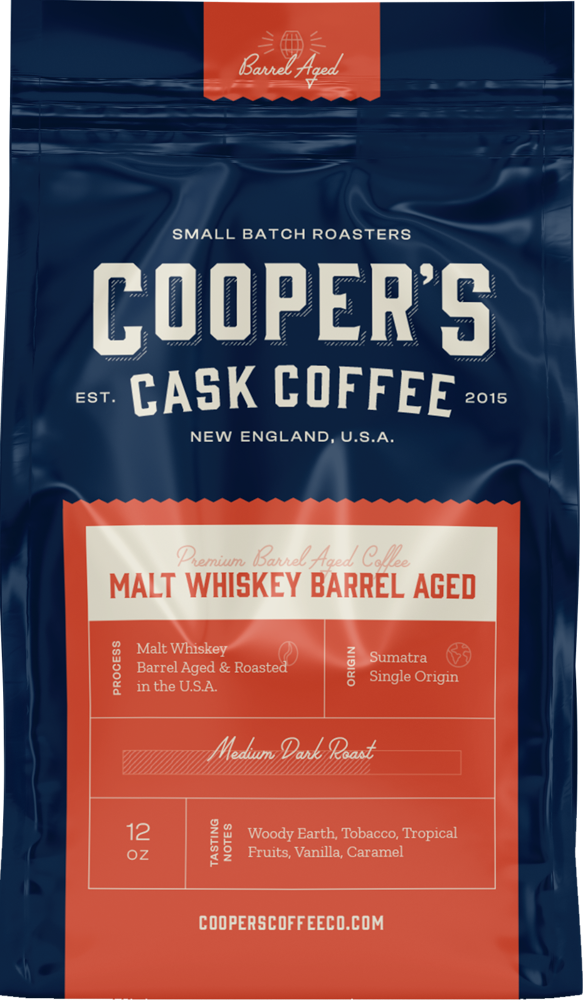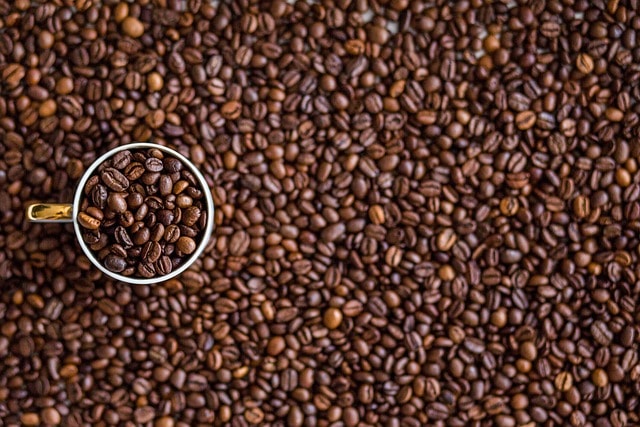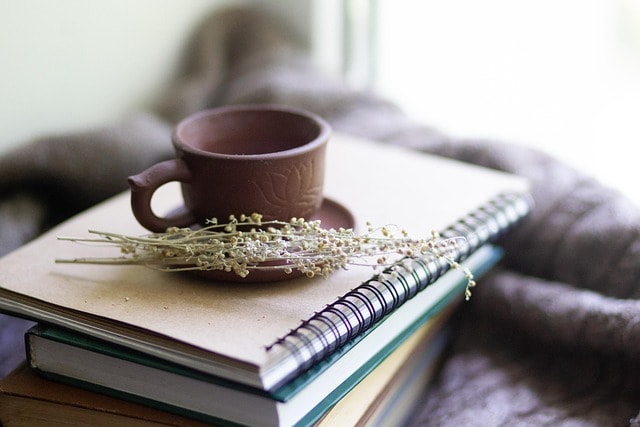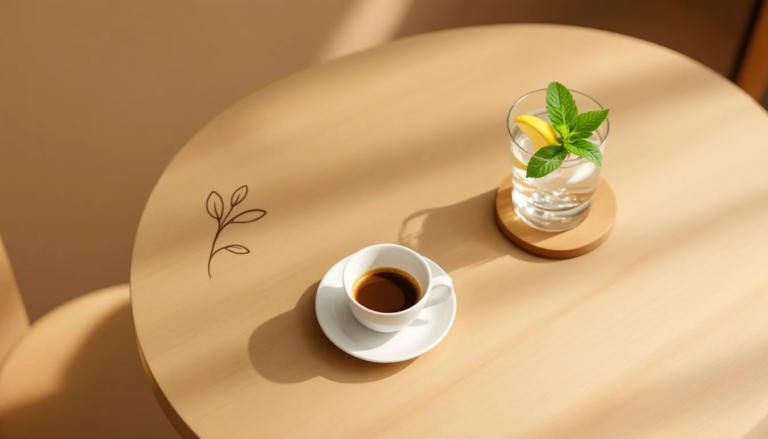Our whiskey barrel aged coffee has created quite a stir among coffee enthusiasts. We’ve been listed as a best barrel aged coffee by Coffee & Health Magazine. Our coffee products have received over 7000 4- and 5-star reviews on Amazon.com.
There’s nothing like an easy morning with a cup of Cooper’s Whiskey Barrel Aged Coffee, a fine cigar, and your dog running around in the yard like a maniac while catching frisbees. Not that we’ve done that before or anything. #YesWeHave
The flavors of whiskey and coffee combine centuries worth of heritage in every bag of beans we ship. Read on to understand the joy and craft involved in creating your new favorite cup of coffee.
Why did Cooper’s Cask Coffee start making barrel aged coffee?
We already loved gourmet, small-batch coffee. Our single origin coffee beans offered flavors unique to the regions in which they were grown. This terroir—the interaction between soil, climate, altitude, and cultivation practices that influences the coffee’s flavor profile—fascinated us.
Discovering the perfect roast to bring out those flavors lets our coffee experts add subjective, measurable science to the art of joyful culinary experiences.
How It All Began
John Speights, a co-founder of the company, saw that some tea companies were aging tea leaves in wine barrels. His first question was “why?” He tried some and recognized how this aging process created a unique taste for the brewed tea.
Curiosity led to a “What if…” moment. First, John tried barrel aged coffees from other companies. He wasn’t impressed with the flavors—because John is a coffee snob (and aren’t we glad he is?!).
However, having enjoyed whiskey and coffee as a beverage, he knew there was something to creating the flavor combination—without the alcohol. John contacted another coffee nerd (and good friend), Jason Maranhao.
They discussed coffee plans and barrel-aging techniques, threw frisbees to dogs, and worked feverishly to create the best-tasting whiskey and rum barrel aged coffee possible.
Et voila. Now, we all have Cooper’s Cask Coffee to enjoy in our own homes.
What is whiskey barrel aged coffee?
At its most basic definition, whiskey barrel aged coffee comes from putting green coffee beans into retired whiskey barrels and aging them there for a few months. By doing so, Cooper’s Cask Coffee enhances and emphasizes the complex flavor profile of the single origin coffee beans.
Is there alcohol in whiskey barrel aged coffee?
No. Though you do get the delicious flavors and aromas of whiskey and coffee, there is zero alcohol in there. No buzz, no worries, just a great taste you can enjoy wherever, whenever.
What is aged coffee?
Barrel aged coffee and aged coffee aren’t the same thing. That might seem like a trick of semantics, but it’s actually a historical fact.
Legend says that drinking a beverage made using coffee fruit (and ergo, the seeds/beans inside them) started around 800 CE in Ethiopia.
Around 1200 CE, coffee drinkers separated the coffee seeds from the fruit and hull. They roasted the seeds/beans on thin, perforated pans over an open fire. The roasted beans were boiled in water, and we got our first cup of coffee.
In the mid-1500’s, roasting and brewing methods appeared in the area we now call Yemen. Those methods were the start of today’s modern coffee roasting and brewing. Travelers discovered this amazing drink and began to export coffee beans around the world.
Coffee Aging Wasn’t by Choice
Because Amazon didn’t exist in the late middle ages, shipping in the 1500’s wasn’t speedy. Items moved by sailing ships over long, arduous sea voyages. It could take months for the green coffee beans to leave Yemen and arrive at their destination.
During this extended transit, the coffee beans underwent a natural aging process which significantly impacted their flavor profile.
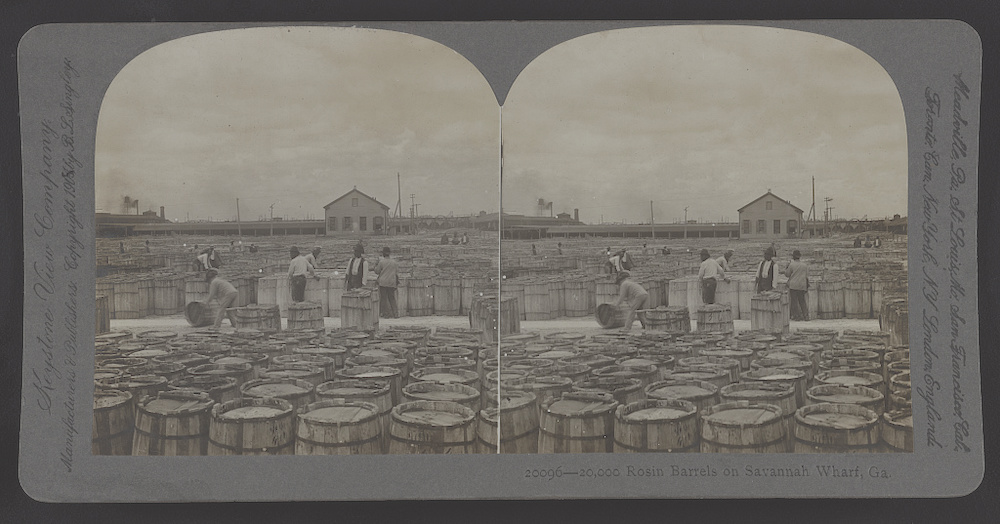
How Early Aging Changed the Beans
As the beans were exposed to the moisture and salty sea air during the voyage, they underwent chemical changes. These changes reduced the bean acidity and enhanced the flavors.
It’s similar to dry-aging beef. When beef is allowed to “hang” for weeks, moisture redistributes in the meat, intensifying the beef flavor, and in this case allowing natural enzymes in the muscle tissue to break down, making the beef more tender.
For green coffee beans, this extended storage period created a smoother, less bitter taste, with more pronounced flavor profiles, including earthy and fruity notes.
Modern Transportation—but Preferred Old-Style Taste
Advancements in transportation and preservation methods meant the beans didn’t age nearly as much—or at all—before reaching their destinations. By the late 19th and early 20th centuries, aged coffee had almost disappeared entirely.
Modern coffee production focuses on delivering fresh coffee quickly. This is done to preserve its flavors and aromas in their natural state, unaffected by storage time and conditions.
However, in recent years, the distinct flavors of aged coffee beans have undergone a renaissance. Coffee has been a mainstay of countries and cultures, defining morning rituals, afternoon re-invigorations, and weekend pleasures—plus all-nighters for finals.
Having been associated with coffee for so long, true coffee lovers want to explore unique taste experiences beyond what is traditionally associated with freshly harvested coffee. This curiosity led to the re-introduction of aging processes for coffee beans. And that led to a group of coffee nerds thinking how whiskey and coffee can combine their best inside the barrel.
We Make Aging Awesome
At Cooper’s Cask Coffee, we have experimented with controlled aging techniques to see how it affects the beans’ flavor profiles. We control humidity levels, ambient temperatures, and storage containers. The last step includes intense cupping processes, testing our coffees’ flavor profiles at multiple roast levels, and choosing the roast that brings out all the best qualities of those single origin beans.
All of this leads us to our barrel aged coffees.
We age beans in various ways, including storing them in wine or whiskey barrels. This requires elevated control of environmental factors, from regulating humidity levels and air circulation, to creating specific environmental conditions that simulate traditional aging.
Our goal is to create distinct flavor profiles that cater to coffee connoisseurs who enjoy an expanded flavor experience. We want the experience to include their favorite types of spirits and/or types of wines—such as whiskey and coffee!
Combinging Whiskey and Coffee: Love at First Sip
One of the most famous cocktails around the globe is Irish Coffee. We have an awesome recipe for it that you should try (when you won’t be driving, mind you). It’s delish, involving any of our single origin coffees along with sugar, heavy cream, and your choice of Irish whiskeys.
But what about whiskey itself? Where did it come from, and why do we love it so much?
A Brief History of Whiskey
To start, your friends might ask you if you’re talking about whisky, or whiskey. Yes, there is a difference. Similar to “champagne” only being used to name the sparkling wine from that part of France, “whisky” only comes from Scotland. Scottish whisky is made from barley or a combination of grains, as single-malt scotch or blended scotch. And yes—if you call it “Scotch,” it’s gotta be made in Scotland too.
“Whiskey” with an E is any other product of fermented grain mash. This can include barley, wheat, rye, or corn. We use whiskeys for both our Malt Whiskey Barrel Aged Coffee and our Rye Whiskey Barrel Aged Coffee.
Where did the name “whiskey” come from?
The origins of whiskey goes back to its creation in various regions, including Ireland, Scotland, and even the United States.
The name “whiskey” comes from the Irish term “uisce beatha,” or the Scottish term “uisge beatha.” Both of these basically mean the same thing: “water of life.” Obviously, the first whiskey distiller were also poets. #ItCouldBe
The terms evolved into “whiskey” as the delicious spirits spread to other regions.
How the “Water of Life” Began
Distillation creates whiskey. Distillation as a process is first known to have occurred in Mesopotamia around 2000 BCE. At that time, they used it to create perfumes and aromatics.
The first written records occurred in Greece 2000+ years later, around 100 CE. Now, if we were betting (and we are), there’s no doubt some able-minded entrepreneurs discovered how distilling could make a liquid that made you feel rather delightful if imbibed judiciously. And we also bet more than one had the “bathtub gin” bad ending to their efforts.
However, in modern times, the first written description of distillation happened in that first century. They describe the process for distilling seawater into drinking water. Chemists in Alexandria, once a major center of thought and discovery (including the Library of Alexandria at its height), used distillation to work with mercury, sulfur, and even arsenic.
An Invasion Sensation for Europe
Around 800 CE, an Arab scientist named Abu Musa Jabir ibn Hayyan created a better still, and he used it to distill beverages. According to some scholarly traditions, a family of doctors by the name of MacVey or Beaton were able to obtain his medical texts. As they were translated, the doctors discovered a recipe for whiskey.
Another tradition states that European monks, already known for wine and beer making, spread through Europe, including Scotland and the Irish isles. Since Scottish soil wasn’t conducive to growing grapes, they monks supposedly turned to other fermentable organics, namely cereal grains.
As for Ireland, in as early as the 12th century, Irish monks get credited with refining the distillation process and using it to produce potent spirits. This tradition says those “potent potables” eventually evolved into whiskey.
The First Recorded Reference to Whiskey
Stepping out of tradition and into recorded history, on June 1, 1494, a Tironensian monk named John Cor in Fife, Scotland, wrote down the first known written reference to scotch whisky. The reference can be found in the Exchequer Rolls of Scotland. This is the government record maintained by the head revenue collector, who also used to make payments from the royal account.
From here on, whiskey distillation spread around the world as travelers (and more than a few monks) brought their skills with them to distant lands.
Whiskey in America
As part of that tasty migration, early American settlers in the 1700s brought their distilling knowledge from Europe. Similar to the monks who arrived in Scotland and adapted their craft to the available resources, these settlers used the abundance of corn in the region as their grain base.
And with that, bourbon—a uniquely American type of whiskey made primarily from corn—was born. Similar to whisky and champagne, the term “bourbon” can only be used to name a spirit made through specific standards within the United States. And now, whiskey and coffee come to light.
How We Make Barrel Aged Coffee
The process of making whiskey barrel aged coffee starts by selecting high-quality, single origin green coffee beans from various regions known for their distinct flavor profiles.
We have chosen spirit and coffee combinations, like whiskey and coffee, bourbon and coffee, and rum and coffee, for their flavor profile compatibility and historic popularity as a combined beverage.
Next, we source the right barrels for the aging process.
Better Barrels for Best Flavors
Barrels for aging spirits and wines aren’t made from any kind of wood. A cooperage—the business that makes barrels and casks—first picks the right kind of wood. Fairly universally, the best wood for barrels is American oak.
Not all American oak will impart the same flavors. Just like how coffees grown in different regions have unique terroirs, the choice of American oak shapes the final flavor of the spirit.
The cooperage receives the oak as dried slats, most commonly called staves. The cooper places each stave by hand into a machine. This machine shapes the staves for the specific size barrel they’re making.
Once prepared, the staves go into a mise en rose, a special ring that holds them in place. Then more metal rings, known as barrel straps, are put around the outside of the barrel to squeeze it into the barrel shape.
As the straps apply pressure, the staves are heated by boiling water, a steam bath, or by flame heating. This heating makes the wood more pliable. If water or steam is used, it can help remove further tannins from the wood.
Feel the Burn
Coopers use several methods to char the barrel’s interior. Regardless of method, the inside of the barrel achieves a depth of char that will shape the flavor of the spirits or wine stored there.
For example, a more deeply charred—or “toasted”—barrel could create a burgundy wine. Higher toasting adds spicier, smokier notes to the contents, along with a vanilla tone. Lightly toasted barrels add more tannin and oak flavoring, as the “raw” wood is closer to the contents because of a shallower char.
Beyond the contents themselves, other factors impact the final product, including:
- Barrel size
- Cask or barrel shape
- Storage environment
- Wet or dry barrel storage
The Barrel Aging Process
There are two ways to age green coffee beans in barrels:
- Wet barrel aging
- Dry barrel aging
At Cooper’s Cask Coffee, our team of coffee aficionados uses the wet barrel method to blend whiskey and coffee flavors before roasting.
Wet Barrel Aging vs. Dry Barrel Aging
As the name implies, one version has a “wet” barrel, while the other uses a dry one. Wet doesn’t mean waterlogged; rather, it means the barrel is freshly dumped. The char on the inside is still wet with the spirits or wine previously stored within it.
Dry barrel aging uses barrels that have been allowed to dry out on the inside. You don’t feel the wetness of the previous contents in the char.
Why Cooper’s Cask Coffee Uses Wet Barrel Aging
The answer is simple: for the flavor. Wet barrel aging puts more authentic flavor and aroma into the beans than with dry aging. It also does so more quickly, meaning our green beans are fresher and ready to be roasted per order.
The wet aging process may impart more of the flavors you enjoy, but that’s not without extra care from our team. We have to be vigilant about the beans within those barrels. If you age them too long, they can become swollen and brittle. These spoiled beans are unsuitable for brewing.
So, we pay extremely close attention to the beans, aging them enough for flavor and proper appearance but not so long that they lose their quality. Depending on the spirits and the beans, aging lasts from 4 to 8 weeks. It’s hard work getting these beans just right, but it’s work we love doing. And we’re pretty darn good at doing it.
The Flavor Profile and Sensory Experience
Whiskey barrel aged coffee offers a unique and complex flavor profile that combines the best of whiskey and coffee. You get the rich, earthy tones of coffee with the sweet, caramel-like notes of whiskey—but no alchohol.
The aging process in the freshly dumped whiskey barrels imparts hints of vanilla, oak, and even a subtle smokiness to the beans.
When you first open your bag of Malt Whiskey Barrel Aged Coffee or Rye Whiskey Barrel Aged Coffee, you catch both the rich and dark roasted aroma of the single origin coffee beans, plus the notes of the whiskey (or bourbon, rum, or wine) that had originally aged in the barrel. It’s almost as if you’ve poured the spirits into your fresh cup of joe already.
While brewing, the aroma of whiskey barrel aged coffee fills the air with an enticing blend of coffee and whiskey scents. But again, don’t fear: There is zero alcohol content in the coffee you brew from our whiskey barrel aged coffees.
Two Arts, One Delicious Cup
Whiskey barrel aged coffee represents the creativity and artistry of both our master coffee roasters and the craft whiskey distillers we’ve chosen to supply our barrels. The final product brings together two distinct crafts—whiskey and coffee—each with its own traditions and histories.
Now you can connect with it all in every sip you take.
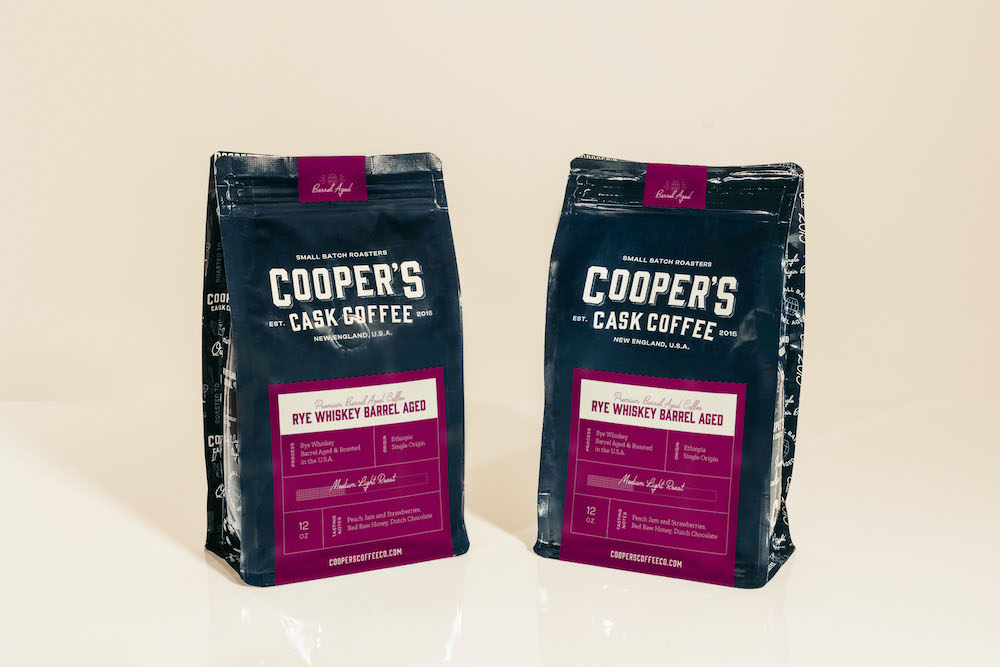
The Whiskey Barrel Aged Coffees at Cooper’s
We offer two different whiskey barrel aged coffees for you to enjoy at your leisure. During your leisure. However you leisure. #LeisureOn
Single Malt American Whiskey Barrel Aged Coffee
Also called “Uprising Coffee,” we start with our single source Sumatra coffee beans. They’re grown in the sub-region of Lintong, chosen because of the complementary tasting notes of woody earth, mild sweet tobacco, and a hint of tropical fruit.
The wet barrels we use to age the beans formerly held Uprising, a single malt American whiskey from craft distiller Sons of Liberty Spirits Company. These barrels infuse additional flavors into the beans along with aroma notes of vanilla and caramel sweetness.
Once the aging process is done for our Malt Whiskey Barrel Aged Coffee, the beans are given a medium-dark roast for a bold and delightful coffee experience.
Rye Whiskey Barrel Aged Coffee
This version of whiskey barrel aged coffee begins life as Ethiopian dry processed single origin green coffee beans. The dry process dries the coffee cherries under the sun, with the fruit intact rather than stripping the cherries after picking. This intensifies the flavor of the cherry flesh into the coffee beans.
We take these green coffee beans and age them in Sons of Liberty “Battle Cry” Rye Whiskey Barrels. These wet barrels infuse accents of dark fruits, honey, and chocolate, with a floral room note and a slightly sweet finish. When you brew our Rye Whiskey Barrel Aged Coffee, you’ll enjoy intense aromas and complex flavors with each cup.
Whiskey Barrel Aged Coffee Isn’t for Everyone
We’d like to think it is, but you need to enjoy whiskey and coffee first. Plus, you’ll have to realize that, although the whiskey flavor notes complement the flavor profile of our single origin coffee beans, the aging process along with the essence of the spirits does change the coffee experience into something new.
We put forth that, unlike “flavored” coffee that uses chemicals and syrups, we let both the rich flavor of the coffee and the bold notes of the whiskey blend. Instead of masking flavors, the two complement one another in delectable harmony. They create whole new complexities of sensory experience between whiskey and coffee, minus the alcohol.
Try Our Other Barrel Aged Coffees
Ask yourself this:
- Do I enjoy whiskey?
- Do I adore bourbon?
- Is rum my jam?
- Is wine just fine with me?
If you answered yes to any (or all) of these questions, we’ve got a coffee that will please your palate. Our Bourbon Barrel Aged Coffee uses only authentic American wet bourbon barrels to deliver a unique treat for your senses. Enjoy your coffee like a pirate with the exotic notes in our Rum Barrel Aged Coffee. If you’re a wine connoisseur, you’ll enjoy our Cabernet Barrel Aged Coffee or our Pinot Noir Barrel Aged Coffee.
Unbox Complete Sets of Our Barrel Aged Best
The Barrel Aged Coffee Box Set contains a sampling of our 4 spirit barrel aged coffees that you can send as whole bean or pre-ground. The set includes:
- Kentucky Bourbon Barrel Aged Coffee
- Malt Whiskey Barrel Aged Coffee
- Rye Whiskey Barrel Aged Coffee
- Rum Barrel Aged Coffee
The Wine Barrel Aged Box Set includes a sampling of our 3 wine barrel aged coffees, including:
- Cabernet Sauvignon Wine Barrel Aged Coffee
- Pinot Noir Wine Barrel Aged Coffee
- Chardonnay Wine Barrel Aged Coffee
Our boxed sets let you sample and enjoy a collection of the freshest coffee in town.
Put Cooper’s Risk-Free Pleasure in Your Cup
Our 100% satisfaction guarantee means that you can try any of our coffees you want. If within 30 days of your order you aren’t wholly satisfied, you can trade it out for another coffee. Or, you can send your order back postage-free, and we’ll return your money.
Pair the Flavors of Whiskey and Coffee Today
Our whiskey barrel aged coffees represent a testament to the rich histories and cultural significance of both whiskey and coffee. We combine the expertise and creativity of artisans in both of these fields, crafting a unique sensory experience that delights and captivates coffee enthusiasts worldwide.
Contact us with your coffee questions. We’ll get back to you as soon as possible to make sure you’ve got the info you need to choose your new favorite coffee. You can also use our online coffee finder tool to curate your next cup.
Plus, we have the coolest coffee gear for brewing, drinking, grinding, and enjoying your barrel aged choices.
Small batch, big satisfaction. That’s Cooper’s Cask Coffee.
Sign up for our email list and get 10% off your first order!
